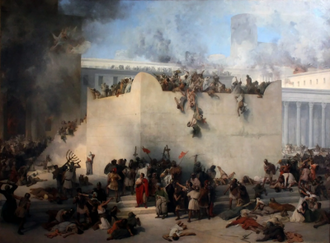Gospel in Art: The destruction of the Temple foretold

The Destruction of the Temple of Jerusalem, by Francesco Hayez, 1867 © Gallerie dell'Accademia, Venice, Italy
Source: Christian Art
Gospel of 28 November 2023
Luke 21:5-11
When some were talking about the Temple, remarking how it was adorned with fine stonework and votive offerings, Jesus said, 'All these things you are staring at now - the time will come when not a single stone will be left on another: everything will be destroyed.' And they put to him this question: 'Master,' they said 'when will this happen, then, and what sign will there be that this is about to take place?'
'Take care not to be deceived,' he said 'because many will come using my name and saying, "I am he" and, "The time is near at hand." Refuse to join them. And when you hear of wars and revolutions, do not be frightened, for this is something that must happen but the end is not so soon.' Then he said to them, 'Nation will fight against nation, and kingdom against kingdom. There will be great earthquakes and plagues and famines here and there; there will be fearful sights and great signs from heaven.'
Reflection on the painting
A lovely start to our reading and relevant to us, who are lovers of art! We hear about Jesus and the disciples admiring the art and architecture of the temple: 'they were remarking how it was adorned with fine stonework and votive offerings'. They must have enjoyed admiring the magnificence of the temple and its surrounding architecture, its carvings, its detailing. The temple must have been one of the 'wonders of the world' at the time, to put it in contemporary terms. But the temple for them was of course more than just the building itself. It was about the presence of God within it, and the gathering of people inside. Yet, as Jesus was admiring and leaving the temple area for the last time before his death, He prophesied the destruction of this temple.
Zooming in on the attitude of the disciples, I think that when they were admiring the beauty of the temple, part of them was thinking that this temple one day would be their Master's palace, where they all could and would be promoted to high positions. So they were asking Jesus about their future, again from a misguided, self-centred point of view.
Jesus' prophecy became true: in 70 AD, Roman legions under Titus destroyed the Temple, about 37 years after the death and resurrection of Christ. Titus tried to save the temple, but his soldiers destroyed it, thus fulfilling Christ's prophecy. When the fire melted the golden works of art and objects, the molten metal ran down between the stones. To get to the gold, the soldiers had to remove the stones one by one, just as Jesus predicted!…
Francesco Hayez painted this large historic painting in a very vivid way. He was based in Milan, and was one of the leading artists of the Romantic movement in Italy, which celebrated important historical events and political allegories, emphasising emotion and glorifying the past. The Destruction of the Temple of Jerusalem is a masterpiece from the painter's later activity. It took him 7 years to complete, from 1860-1867. He decided to donate the painting to the Accademia in Venice where he had received his artistic training more than half a century earlier. The painting is still housed there today. The visually impactful composition depicts the destruction of the temple at the very moment the carnage is at its height. The building is engulfed in flames and the destructive fury is at its climax.
LINKS
Gospel in Art: https://christian.art/
Today's Reflection: https://christian.art/daily-gospel-reading/luke-21-5-11-2023/


















